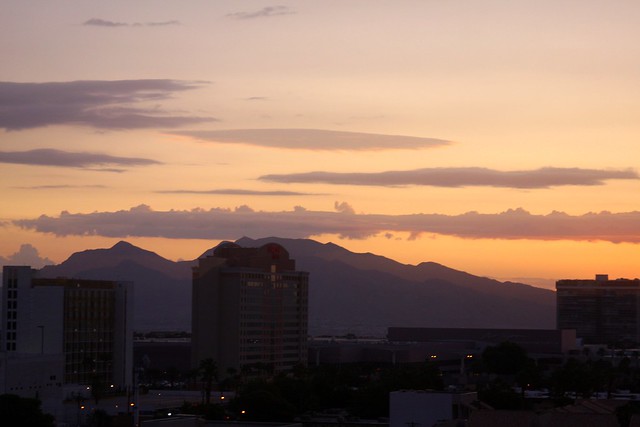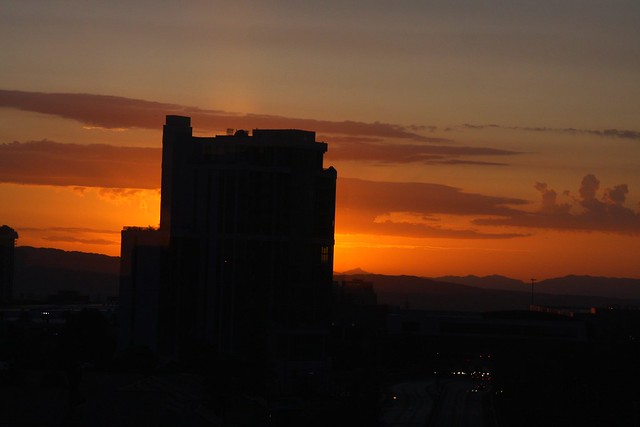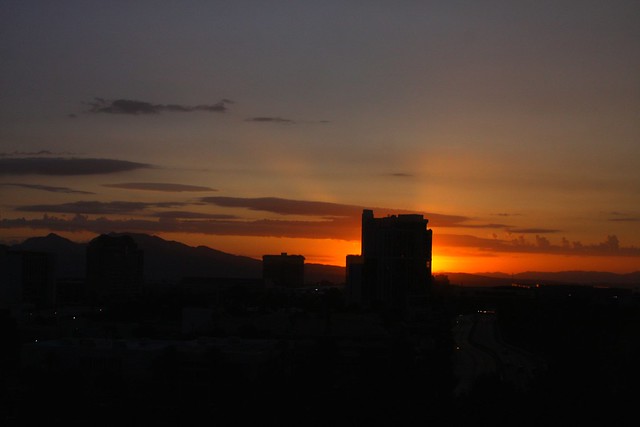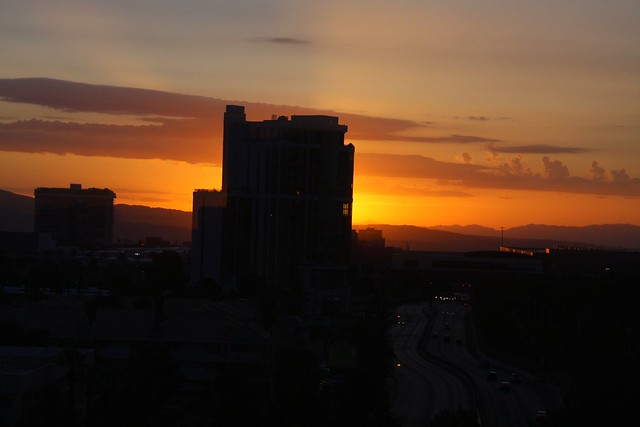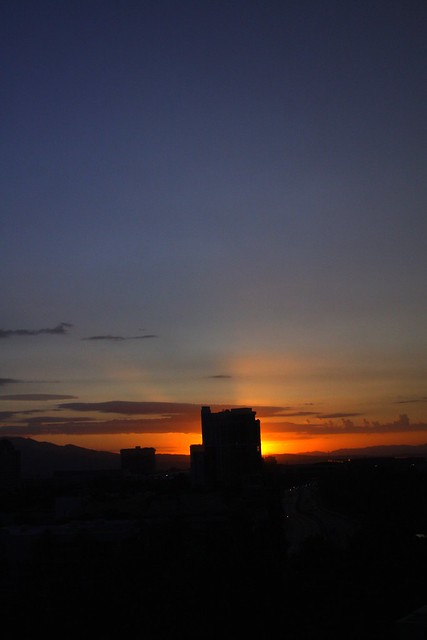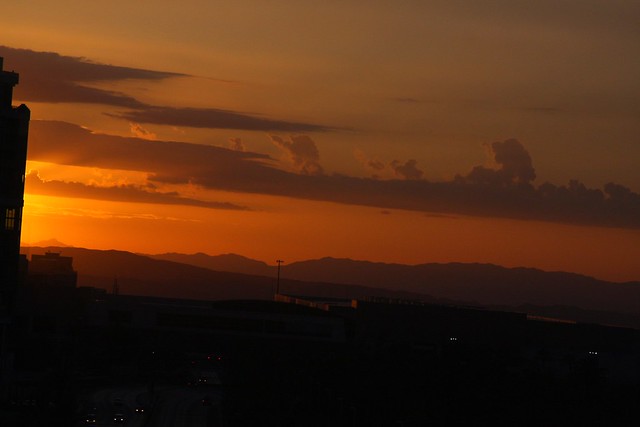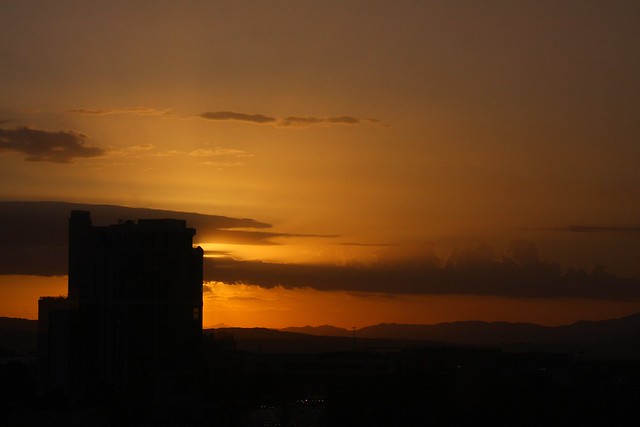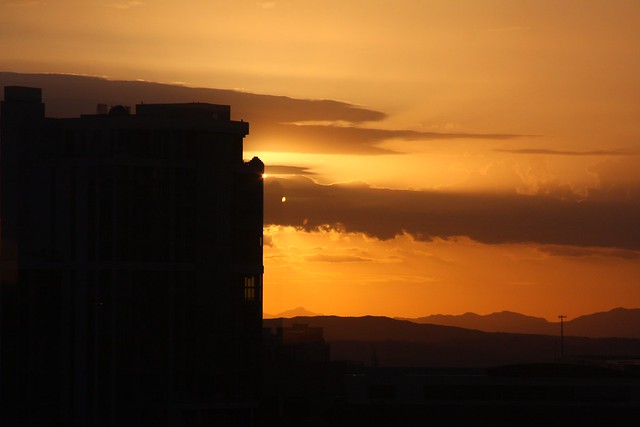I thought I'd try something different here on this humble blog. Longtime readers might have noticed that I often reference the Multnomah County Library's Oregonian newspaper archives. Usually I do this to flesh out the historical background on something obscure I found around town and took photos of. This time I thought I'd start with the database, pick out a place and a time period to search on, and just see what the paper had to say.
I settled on
Kelly Butte as the subject for this, since it's an mysterious and little-known place and I've already milked it for quite a few page views over the years. For the time period, I went with a five year span starting in 1906, since -- at least according to the database's imperfect OCR system -- this is around the time people started calling it "Kelly Butte" rather than "Kelly's Butte" -- which sounds like the sort of place where desperadoes cut you off at the pass or something.
The city's nuclear bunker was still half a century in the future, but Kelly Butte wasn't just a pastoral wilderness in the early 20th century. In 1906 the county opened a new jail and rock quarry at Kelly Butte, and most of the news items over our five year period are of problems with running the jail, and of miscreants being sent there.
When a convict was sent to Kelly Butte, it was a sentence to hard labor, breaking rocks in the hot sun, just like the cliche. Except for the hot sun part, this being Portland and all. The part that always confused me about the whole breaking rocks thing was what the purpose of it all was, other than just to be mean to prisoners. It turns out that, at least in the Portland case, we needed all that gravel for road construction. In 1906 Multnomah County was just beginning to pave local roads, and the county needed a massive supply of gravel for all that paving work. Prison labor was cheap, and prisoners couldn't up and quit when they realized how miserable and dangerous the work was. The quarry operated for quite some time, so if you live anywhere in SE Portland the roads you drive or ride on were first paved with prison labor gravel from Kelly Butte.
As this was before the advent of modern heavy machinery, the gravel operation needed a substantial labor force. And as you'll see, the county obliged by sentencing people to months of hard labor for laughably trivial offenses. If the authorities merely felt you were the wrong sort of person, they'd find a way to ship you off to "the rockpile", as Kelly Butte was then nicknamed.
Multnomah County was organized on the County Court system at the time -- a system still used by rural counties around Oregon -- in which the county commission is chaired by a County Judge, who doubles as, well, a judge. So the same person could (and did) order the construction of a new jail and then sentence people to break rocks there. And as this was before the advent of modern conflict-of-interest laws, the same judge could also serve as a prominent member of the local Good Roads Association, lobbying for more and better paved roads. It seems to have been quite a cozy arrangement. I haven't yet searched the archives to see just how long it went on or what eventually became of it.
I haven't come across any examples of the Oregonian or the general public objecting to this arrangement. Although this is probably a good time to remind everyone that a local newspaper is not an objective source of historical facts or even a mirror of contemporary public opinion. This is true now, and was even more true in 1906; the Oregonian of that day reads like a combination of the Portland Mercury, a British tabloid, and The Onion. The paper reveled in lurid crime stories, and gleefully sneered at everyone involved. Which makes the articles fun, often hilarious to read, but perhaps not always reliable as historical documents.
That said, I do get a sense there was something more to this rockpile business beyond the paving racket. Portland was still a lusty seaport of the Old West in those days, full of unattached young men seeking their fortune by means fair or foul. They seem to have made the authorities rather anxious. More than once an offender was given a choice: Go to the rockpile for 90 days and do some good honest manual labor (which presumably was a first step toward settling down and becoming a respectable citizen), or leave town on the next ship or train and never return. It would be interesting to learn which option was more popular.
NOTE: If you want to follow the links here you're going to need a Multnomah County library card, or some other way of accessing the America's Historical Newspapers database. I've excerpted some of the news articles here so everyone can at least get a taste of what the 1906 Oregonian was like. The newspaper database is quite fascinating, and I highly recommend checking it out if you can, although browsing through it can easily suck up hours or days of your time if you let it.
Also note that this post currently peters out in mid-1910. I'd stopped there when I was initially writing it, and then the post lingered around in the Drafts folder awaiting further action. So I decided I'd go ahead and publish it now, and either leave the rest of 1910 as an exercise for the reader, or do the rest at some future date and update the post at that point, and hopefully remember to remove this little notice so as not to confuse people.
1906
- Road to the Rock Quarry, March 6th, 1906
The county is to open a road to the rock quarry, recently secured at Kelly Butte, between the Section Line and Powell Valley roads, preparatory to undertaking some extensive road construction. There are 12 acres in the tract, and the rock is considered the best for road work found anywhere near Portland. It is proposed to complete the road to the quarry and take out rock for the crusher. The gravel that has been used for so many years on the county roads of Multnomah was excellent for the time when travel had not become so heavy as at present, nor where the loads on the farmers' wagons so heavy as at present. The gravel roads are now quickly cut to pieces by the tremendous travel to Portland, and hence the county will give the roads a coating of crushed rock, which will stand the heaviest possible wear. Judge Webster has announced that the roads of Multnomah County are to be made the best in the state and models of construction, which may now be done, as the county is out of debt. The quarry at Kelly Butte is central and accessible from all portions of the county.
- July 6, 1906:
PLAN BRANCH JAIL
---
It Will Adjoin the Kelly Butte Quarry
---
SAVING IN TIME PROPOSED
---
Prisoners Will Work Ten Hours a
Day and Will Not Have to Go
From and Come to Multnomah Jail
The new structure will be 67 feet long, 22 feet wide, and the walls 12 feet high. The floor will be of cement and the roof constructed of sheet iron. The walls will be strong enough to withstand any attempted outbreak by the prisoners. There will be 48 bunks, and accommodations for eight guards, although that number will not be employed.
...
The structure will cost about $3000 and similar buildings may be erected close to other rock quarries.
The prisoners are to be worked ten hours a day getting the rock from the butte and crushing it. A traction engine will haul the rock to the crusher. Kelly Butte contains 12 acres of solid rock 80 feet high.
County Judge Webster, commissioners Barnes & Lightner
- September 16th, 1906 obit for Plympton Kelly, described as "a pioneer of 1848", and son of prominent pioneer "Father" Clinton Kelly.
There were five sons in the Kelly family, and all helped in clearing the home farm that comprised Waverly, Kenilworth, and Richmond, in the southeastern portion of Portland. In 1850 Plympton filed on 350 acres of Government land on the Section Line road, erected a log cabin, and then went to work to clear away the heavy growth of timber. It is known as the Kelly Butte farm. By dint of hard work, he developed one of the finest farms in Multnomah County.
- STOP MAKING EYES, November 6, 1906. Wherein the city threatens to arrest all men found idling about town and leering at women, and send them up for an arduous course at "Rock College", a.k.a. the Kelly Butte quarry. The Oregonian reports all of this with great glee. It reads like something out of The Onion, really.
- A followup piece from the next day, wherein a Captain Slover of the city police said "Combined with the threat of the rockpile at Kelly Butte, the order had the effect of clearing out the many professional idlers in the North End. It is wonderful what magic there is in the rockpile."
- The first prisoners arrived at Kelly Butte the same day, all convicted for vagrancy and sentenced to break rocks for terms between 20 and 90 days.
Chief of Police Gritzmacher is elated over the fact that in the future city prisoners found guilty of vagrancy and other misdemeanors must serve time at rock-breaking instead of being held in jail, fed three square meals a day and kept warm with fires paid for by the city.
It is the prediction of Chief Gritzmacher that there will be much less crime this Winter because of the establishment of the rockpile.
The article makes sure to point out that one prisoner, a certain Hugh Simmons, was also known as the "Jamaica Coon". No doubt they realized their readers cared deeply about such details.
- Dr. Ganzer Fractures Rock Clad in His Sunday Best, October 27, 1906, wherein a certain "Doctor" Ganzer feels that breaking rocks at the quarry is beneath him, and soon gets his comeuppance.
- A brief item from November 25, 1906:
Portland has a lot of Caruso "mashers", especially cigar store and street corner "johnnies", who, while not "pinching" their victims, otherwise make themselves a nuisance. Regimen at Kelly's Butte would do them good.
Yeah, blame it all on that Enrico Caruso and his operatic stylings, corrupting the youth of America. I'm guessing this is a derogatory reference to Italian immigrants, but early 20th Century slang can be impenetrable at times.
1907
- Oak-Street Social Happenings, January 25, 1907, wherein a prominent idler (whose crime isn't entirely clear) is permitted to catch the next windjammer to South Africa instead of breaking rocks for six months.
- A brief strike by the prisoners, March 1907, in which they demanded 8 hour workdays. So the county stopped feeding them until they relented.
- A suicide attempt (dated June 7, 1907), by an "Opium Fiend" incarcerated on Kelly Butte and unable to obtain opium. This was considered quite hilarious in 1907.
- August 19, 1907: A local Methodist minister was arranging to drop by on Sundays and preach at the inmates, and send volunteers around every few days bearing flowers and religious tracts.
- September 16, 1907: The first newspaper report of an escape from Kelly Butte. Jack Earle, a former private detective, was convicted for contributing to the delinquency of a minor, namely two minor girls found in his company in a North End saloon. He then jumped bail and fled to LA before being recaptured. It was suspected that he had accomplices in his escape, his wife among them, and he was also considered a master of disguise due to his private detective work. The Oregonian speculated that he may have fled south, and might not be recaptured this time.
Toward the bottom of the article, it's mentioned in passing that this was not the first escape from the butte, but other escapees had been recaptured eventually. Note that the prison was only about a year old at this point, and the county had initially bragged its walls would thwart any escape attempts. Hmm. Go figure.
- There are several instances where a ne'er-do-well was given a choice: Leave town posthaste, or go break some rocks for us. For example, the October 19, 1907 paper had the tale of a notorious Chicago pickpocket named Jimmy Bryant, nabbed while doing his thing at the Multnomah County Fair in Gresham. (The fair was held much later in the year in those days, it seems). He'd been convicted before, along with a pair of associates, for, uh, working the crowd during a visit by President Roosevelt in 1903. Also had a 1901 arrest in New Orleans for pickpocketing during a carnival, along with another band of associates. The article's worth it just for the colorful nicknames.
- In the same month, on October 31, the paper reported a lurid domestic case among the toiling classes. After reporting the juicy details and recounting various incidents involving the unhappy couple, the Oregonian states "Roach was found guilty and sentenced to treat his wife better on penalty of being sent to the Kelly Butte training school for athletic young husbands".
1908
- February 20, 1908, saw a report of an ongoing ugly feud between the County Court and the Sheriff over who was responsible for running the "rockpile", and whose budget paid for feeding inmates. Not entirely unlike the Mean Girls vs. Bernie Giusto feuding of a few years ago.
- The 27th of the same month saw another feud, this time between a County Commissioner and the Mayor of Portland, the latter claiming that Kelly Butte was churning out an inferior product. The article refers to the "Base Line, Powell, and Section Line roads", where "Base Line" is today's Stark, and "Section Line" is Division.
- Two days later came an amusing exchange between Mayor Lane and City Auditor Barbur regarding the firing of a street sweeper:
"Brooks was employed in the Streetcleaning Departent", explained Auditor Barbur
"What is he doing now?" asked C.A. Cogswell, a member of the Board.
"Breaking rock at Kelly Butte", replied the Auditor. He was found guilty of a misdemeanor, and the Municipal Judge sent him to the rockpile."
"Then he is in the street work yet", remarked the Mayor. "And crushed rock is scarce, too."
- On May 16, 1908, MAX THE MASHER IS SENTENCED TO KELLY BUTTE ROCKPILE, subtitled "Washington-Street Lady-Killer Will Exercise His Fascinating Arts on Big Boulders at County Stockade for Next 60 Days". Let me again point out this is the real Oregonian, not The Onion. Apparently Max, a.k.a. Marcus, who "owns a bootblack stand somewhere", liked to hang out daily at the corner of 12th & Washington (now home to the fancy Indigo condo tower), roguishly tipping his hat to ladies not of his acquaintance. Yes, that was his entire crime, as far as we are informed. Tacky behavior, sure, but 60 days breaking rocks? Sheesh.
- June 5, 1908: 40,000 PEOPLE SEE AUTO RACES. On this day Kelly Butte was part of the course for the Northwest's very first automobile race. Two races, in fact, both consisting of multiple circuits of a 14 mile course around Portland's outer eastside. Seven cars started the 50 mile edition, but only two finished, with the others coming to grief at Kelly Butte, Gresham, or the Gravel Pit. The winning time was a blistering 1 hour, 13 minutes. The paper proudly notes that despite all the breakdowns and crashes, not a man was hurt during the races. So there's that.
- August 4, 1908, in City News In Brief a prisoner broke his ankle while fleeing falling boulders from a dynamite blast. Yikes! In other news, a local inventor announced his amazing new musical instrument, the "Pneumatone". I found a picture ad for one in the October 1912 issue of Popular Science, page 112. I could be wrong about this, since he was awarded a patent and all, but it sure looks like a fancy sort of kazoo.
Also, we're informed about the hugely successful fruit trees belonging to J.H. Revenue, on his farm east of Sandy. If that surname sounds familiar, you may remember a recent post here about the Revenue Bridge over the Sandy River, which is a whole other historical tale.
- On September 18, 1908, Kelly Butte was visited by a grand jury, which was trying to puzzle out the ongoing feud between the Sheriff and the County Commissioners.
- And on October 3, 1908, the grand jury asked a judge to rule on what the current law meant, which he did. In passing, the story mentioned that the guy who broke his ankle back in August was now suing the city for damages.
- November 18, 1908 saw another inmate strike, this time demanding that one of their number be released from the "dungeon". Which I think is 1908-speak for "solitary confinement".
- The next day, the grand jury reported back, stating they were pleased with the current state of affairs. They further recommended that the county repeat the experiment on Wiberg Butte, now known as Rocky Butte. The county later did this, and that jail operated until the mid 1980s.
- On the same day, the sheriff personally helped recapture a Kelly Butte escapee.
- And on the 20th, the prisoners strike ended. As with the previous strike, they eventually knuckled under due to lack of food.
1909
- And then, on January 2, 1909: EX-GUARD CHARGES MURDER AT BUTTE, subtitled "Johnson Alleges Most Brutal Conditions". Johnson, a former guard turned whistleblower, went public with claims about mismanagement and officially sanctioned brutality at the Kelly Butte jail. In one case, a prisoner was brutally beaten by others as jail officials chose not to intervene, and the prisoner died of internal injuries a few days later. This beating, it seems, was directly related to the recent inmates' strike.
Oh, and the jail administrator then decided on his own to release the guy responsible for the murder, for reasons as yet unknown.
- On the 4th, a brief editorial concurring with the criticism.
- And on the 5th, Johnson met with the grand jury, which was continuing to investigate the Kelly Butte situation.
- On January 31st came the grand jury's final report. It seems they visited the butte again on the 13th, were treated to a nice hot meal and a demonstration of the jail's bloodhounds, and concluded everything was great. In fact, the place really needed expanding.
Elsewhere, they also recommended replacing the current Poorfarm with a location outside city limits. This later happened, the Poorfarm was moved to Troutdale, and eventually became the McMenamins Edgefield complex. FWIW.
- On the same day, however, it was announced the sheriff would take over running the jail, with personnel changes:
In the first place, the County Court and Commissioners, and particularly Judge Webster, was desirous of retaining Superintendent A.S. Briggs. The Sheriff would not hear of this, for no man ever in the employ of the County has been so generally and persistently charged with incapacity in public office. So Briggs must go.
- On February 6th, the lawsuit by the prisoner injured in the boulder incident had his case nonsuited (i.e. thrown out) on a technicality.
- March 6th, someone was sent to break rocks for stealing copper wire from a rail line near Estacada. Which is a surprisingly contemporary-sounding crime. Or today's examples are a surprisingly retro crime. I'm not entirely sure.
- March 11th, another prisoner strike, this time for better food. They held out for a few days before capitulating on the 16th.
- April 1: Rumors circulate that A.S. Briggs is in line to run a new rockpile, this time in the Linnton area. April fools? We'll see...
- April 17: Yet another escape. This time the guy escaped by scaling sheer rocks as they were preparing to start blasting. He made it as far as Gresham before being recaptured, and the article speculates he had help.
- April 32: Why yes, Mr. Bill Squires did have help during his escape attempt, a pair of area farmers who assisted him:
With a full knowledge that the man was an escaping criminal, these farmers provided him with a hat and coat, instructed him to walk in a furrow so they could plow it under and thus throw the pursuing dogs off the scent, and also offered him a gun, which would be handy in case it became necessary to do the Tracy act and kill the Deputy Sheriffs who were in pursuit. The accomodating gentlemen who were so willing to aid in starting a possible line of tragedies were arrested, but the grand jury failed to return a true bill against them. This will be very pleasing news to the rest of the convicts, who might have been deterred from a jailbreak by the belief that they would get no such warm welcome from the citizens in the vicinity of the rockpile.
- May 9: Grand plans were announced for Mt. Tabor, with a new park, new reservoirs, and new homes & streets, served by a new streetcar line. The article mentions the possibility of extending the streetcar to Kelly Butte to serve the county rockpile, for the transport of prisoners and crushed rock. The transportation issue had been discussed repeatedly since the jail's inception, but had never been addressed.
- May 26: Fred Fisher, a former cook at Kelly Butte, was arrested and charged with having a pair of stolen revolvers. He worked at the butte during the Briggs administration, and was dismissed shortly after the change in control.
- June 9: As rumored, former superintendent A.S. Briggs was picked to run the new quarry up in Linnton. The article states that, despite being a county facility, the quarry will be worked by city prisoners. Presumably so the quarry won't fall under the purview of the county sheriff. The county seemed to be going to absurd lengths just to spite the sheriff and benefit one favored minor civil servant. One gets the strong impression that there's more to the story than the paper is telling us. Perhaps Briggs kept the daguerrotypes, as they say.
- July 7: The county planned to let prisoners earn a small amount of money during their stay, to prevent them from being completely destitute after being released (and presumably then reoffending).
- July 20's City News In Brief brings us this bit of period color:
PARDONED; WILL MARRY WOMAN
David La Mora, sentenced to Kelly Butte for a year by Circuit Judge Bonaugh upon conviction of a statutory offense, has been pardoned by Governor Benson, and was released from the County Jail yesterday afternoon. The pardon was conditional upon his marriage to Frances Meyers, an employee at the Yale Laundry. La Mora was at first given to understand that he would be held in jail until after the marriage, but when he said he had no money with which to purchase a license, or to pay the preacher or judge as the case might be, he was released with consent of District Attorney Cameron.
- August 12: News of a government lottery giving away lands on the Flathead Indian Reservation. Although the article just says "Flathead Reservation" and fails to even mention the existence of any Indians. One of the lucky winners just so happened to be serving time on Kelly Butte during the auction, but as a Spanish-American War vet he was entitled to send a proxy.
- And then, on August 19, the county announced it would abandon the Kelly Butte works and rely exclusively on stone from Mr. Briggs's operation in Linnton. The county insisted that very little paving work remained to be done within hauling distance of Kelly Butte, except for a few miles here and there, so there was no longer any need for the operation. How... convenient...
- On the same day, this small item:
INSULTS GIRL; WILL BREAK ROCK. --
Della Livingood, a 17-yearl-old street singer, was complainant in Municipal Court yesterday morning against Gus Berg, arrested Tuesday night by Deputy Sheriff Beatty, for telling the girl her singing was "rotten". "I am a plain-spoken man", Berg told Judge Bennett. "I will give you 10 days at Kelly Butte," said Judge Bennett. "That may give you time to deliberate before speaking to young ladies on the street."
- The next day brought news that the jail may not close after all, assuming a delayed rail line is finally completed.
- September 2: The new Linnton quarry officially opened for business, and a number of city prisoners were moved there from Kelly Butte. It's amazing how fast things can happen when you don't have basic environmental, safety, or zoning laws in place.
- September 16: Bill Squires tried to escape again, but this time didn't make it off the prison grounds. Not a very impressive escape attempt this time; it was the old "run for the fence when the guard turns his head" trick. Whereupon the guards tried the old "shoot at their feet a couple of times and watch them give up" trick.
- September 22: Kelly Butte received an official visit by Mrs. J. Ellen Foster, Government Inspector of Prisons. The article mentions that she looked favorably on the Kelly Butte operation, but much of the piece is devoted to marveling at the novelty of an important female federal official. It does mention in passing that Mrs. Foster had special praise for the work of Lola Baldwin, the country's first female police officer.
- September 23: The ongoing feud between the County Court and the Sheriff continued, with a new report from the county claiming that feeding prisoners was twice as expensive after the sheriff took over the jail. The sheriff pulled no punches in his reply, arguing that the numbers for the time before he took over were inaccurate and far too low:
"For instance, it was formerly a very common occurrence for men sentenced to long terms on the rockpile to vanish suddenly, after eating a few meals, and never to be heard of again. As most of these escapes were carefully concealed from the public, these elopements would leave, in sme cases, a surplus of several hundred meals to be used in reducing the 'per capita' cost for the others.
"Opium smoking and whisky drinking were also quite freely practiced among the prisoners, and as 50 cents worth of opium would take the place of $5 worth of food, there was a mathematical saving effected from that cause. To make the meal account fit the sentence account may have simplified the bookkeeping, but it was a method by which it was fully as difficult to determine accurately the cost per meal as it would be to tell how much the county is paying Judge Webster for his vacations and private law practice and how much for looking after the work of the county. I have never been able to secure any accurate data on the amount of rock crushed, either this year or last, but am not surprised at the showing made by the County Court.
"With the vast sums of money which the Court has been spending on the roads in ever-increasing amounts, it was a very simple mathematical problem to figure the cost of meals down to a mere fraction. Yet no practical man who ever engaged in the business of feeding people as a business venture ever believed they could be fed, except mathematically or theoretically, at the prices claimed by the County Court, without a loss. Inasmuch as the work of figuring down the price of meals and figuring up the output of rock under the old regime will enable some of the hard-working Commissioners to get in 'per diem' that otherwise might escape them, I am willing that the Court should follow the same practice with the crushed rock that it has followed with the meals"
- November 24: The city proposed building a "detention hospital" on or near Kelly Butte, on land donated by the county. A "detention hospital" being an involuntary quarantine facility for people with contagious diseases. The location was hailed as an ideal one, although it turns out this was Plan B. Plan A would have been a westside location along Canyon Road, but a city councilman owned land nearby and didn't want a detention hospital in his neighborhood.
- November 27: Proving that the only thing new about NIMBY is the acronym, the proposed detention hospital ran into local opposition, from people who quite emphatically did not want this in their backyards. Although one local landowner suggested that putting it on top of Kelly Butte instead of right on the Section Line road might not damage property values quite so much. Notably, this time the Oregonian refers to the institution not as a "detention hospital" but as a "pesthouse", which seems like a much more pejorative term.
- December 3: Another grand jury review of the county's operations gave Kelly Butte far from stellar marks, primarily due to overcrowded jail space. Colorful phrasing abounds: "Kelly Butte Disgraceful", "Kelly Butte quarters cramped and very unsanitary; disgrace to civilization", "Kelly Butte Disgusting", "In the name of common decency we ask that this be remedied at once." The report goes on to criticize broken kitchen ranges, a lack of modern electric lighting, and the use of unsanitary wooden bunks instead of modern iron ones.
I get the impression that grand juries were once used for a sort of general inspection & external audit of the county's operations. It's not clear whether that was actually a valuable function or not, but it's an interesting idea in the abstract.
1910
- January 11: More metal thieving, with two culprits being sent to the rockpile. Of the other pair: "When asked why they stole the wire, they said they were 'broke' and needed the money."
- January 29: CARD-PLAYER IS CONVICTED. Apparently the simple act of playing a friendly game of draw poker was a crime in 1910 Portland, despite being a traditional pastime of the Old West. The case at hand illustrates the one upside of this prohibition: If you happened to lose $400 during a five day poker marathon, you could always call the cops and rat out the guys who took your money. And off they go to break rocks. Of course you got a similar sentence, since you weren't exactly innocent either. And then they were pardoned, and you got your sentence suspended, and everyone switched over to civil court to continue fighting over that $400.
It's interesting to note, apropos of nothing, that later the authorities sorted out the poker problem by simply legalizing it. And curiously, the world didn't end. Just sayin'.
- February 20: More on the proposed pesthouse, which they now describe simply as a "smallpox hospital". When you put it that way, I frankly wouldn't want it in my backyard either.
- February 26: A very 1910 story: Man cons two other men out of the princely sum of $14. Man is sentenced to six months. Man is in no condition to break rocks. Man's son writes half-literate tearjerking letter to judge, explaining that his mother is distraught, and he (the child) is unable to earn enough to support the family in his father's absence. Judge sends them a check from his own pocket, court recommends a pardon.
- March 17: A piece about the good roads movement mentions that County Judge Webster belongs to the Good Roads Association. Lobbying for paved roads while supplying the raw materials for paved roads seems just a little conflict-of-interest-ish, doesn't it?
- April 24: Another story with a kid in it, but less of a family togetherness angle. Seems his dad had a beef with the neighbors, and decided to resolve it by dynamiting their cabin. Son inadvertently rats out his dad when, under questioning, said he saw his dad stockpiling dynamite. When asked how he knew it was dynamite, he said he knew the smell from riding on wagons to Kelly Butte.
- May 22: Another example of a crime that actually isn't new:
An individual of the male gender, incarcerated at Kelly Butte by the county on conviction by the city of attempting assault upon a little girl, seeks freedom on the ground that the city cannot send one of its prisoners beyond city limits for punishment. But for an offense like this the city should have authority to send the culprit to one of a variety of places, one of which is so far away that no traveler has ever returned from it.
